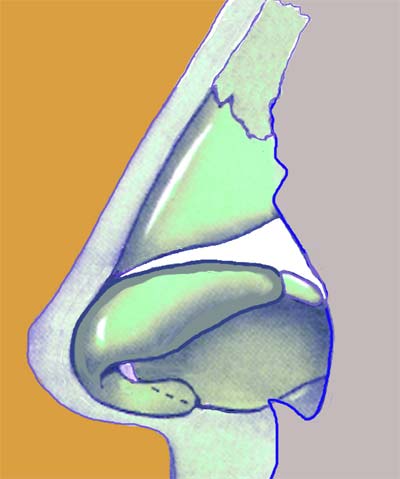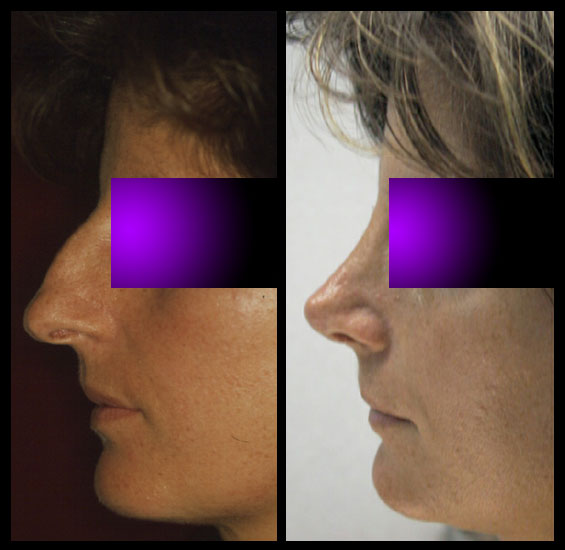
Rhinoplasty
 Rhinoplasty is an aesthetic surgery procedure planned and performed to improve facial appearance through the correction of the external shape, size and volume of the nose.
Rhinoplasty is an aesthetic surgery procedure planned and performed to improve facial appearance through the correction of the external shape, size and volume of the nose.
The nose can be corrected with the help of modern plastic surgery, but it is important to be respectful of each subject‚s facial characteristics, eye expression and mimic. A rhinoplasty can be considered successful when the casual observer will not be able to guess that a surgical procedure might have been performed. In a normal nose that has never been traumatized, several kinds of irregularities might co-exist due to an umbalance among the different structures making up its frame. An example might be found in nostrils, that are never precisely alike, nor located in the exact sameposition in the two halves of the face. Another example is given by the nasal pyramid that is frequently deviated towards one side or interested by irregularities of the dorsum. Some of these irregularities are so characteristic to be considered stylish and have been taken as a parameter for incidental corrections. These are the cases in which, starting from a natural nose, one should try to avoid that any surgical procedure leads to an "artificial" appearance. On one hand, it is necessary for the surgeon to know what exactly the patient expects from a rhinoplasty. On the other hand it is important to understand ahead of time if (or how much) the patient's wishes are compatible with the overall balance, the harmony and the natural look of the face that is about to be operated on. Among aesthetic surgery operations rhinoplasty is certainly the most asked for. It is frequent to see patients showing what kind of profile they want to achieve by pointing at the face of somebody else on a picture. This can be useful, since a precise image can easily explain what could hardly be described in words. It is good to notice, though, that a nose that fits perfectly a certain kind of face might not be suitable for another and alter its harmony. According to our protocol, we develop pictures of your profiles (following standard projections) that will later be elaborated by means of computer imaging so as to study which correction can bring the best results, once the tissues have settled after the surgical trauma.Such imaging is performed with the purposeof semplifying the description of what one aims at obtaining from a surgical point of view. The image must not be considered the exact copy of the face after the operation, nor a mean to entice patients to undergo a rhinoplasty.
On one hand, it is necessary for the surgeon to know what exactly the patient expects from a rhinoplasty. On the other hand it is important to understand ahead of time if (or how much) the patient's wishes are compatible with the overall balance, the harmony and the natural look of the face that is about to be operated on. Among aesthetic surgery operations rhinoplasty is certainly the most asked for. It is frequent to see patients showing what kind of profile they want to achieve by pointing at the face of somebody else on a picture. This can be useful, since a precise image can easily explain what could hardly be described in words. It is good to notice, though, that a nose that fits perfectly a certain kind of face might not be suitable for another and alter its harmony. According to our protocol, we develop pictures of your profiles (following standard projections) that will later be elaborated by means of computer imaging so as to study which correction can bring the best results, once the tissues have settled after the surgical trauma.Such imaging is performed with the purposeof semplifying the description of what one aims at obtaining from a surgical point of view. The image must not be considered the exact copy of the face after the operation, nor a mean to entice patients to undergo a rhinoplasty.
Surgical Technique
The skin incisions performed to reshape the nasal pyramid concern the internal side of the nose. This way there are no signs on the outside that might reveal that an intervention was performed. In some cases a little columellar incision can actually be necessary. The residual scar will be almost invisible a few months after the operation. In case this maneuver is needed the surgeon will certainly illustrate where exactly the little scar will end up being. The nose skin is undermined so as to separate it from the below-lying cartilaginous and bony tissues, the excess of which is removed. When necessary the bending in the cartilages making up the nose tip structure can be modified. The nose is frequently shortened to suit the new profile.
Being the cutis very elastic, the skin excess resulting from the volumetrical reduction of the nasal frame easily shrinks so as to fit the new size. Should the skin of the nasal dorsum be particularly thick, any correction of the skeletal structure will become less evident on the outside. In case the profile needs more projection cartilage grafts will be inserted. The latter can be harvested from the nasal septum or, shouldn't it be possible, from the auricular chonca cartilage. Costal cartilage is taken only in very peculiar cases.
When the nostrils are too wide little slices of skin will be removed to sharpen the nose. This will lead to little scars at the basis of the nostrils. The quality of the scars largely depends, like in any operation, on the characteristics of the patient's skin. All these technical details need to be discussed over with the patient before the intervention.
Duration of the procedure
According to the complexity of the corrections to be performed, the operation may last from 1 to 2 hours.
Anesthesia
The intervention is performed under local anesthesia with a slight IV sedation and local infiltration of a drug that limits intraoperative bleeding. Alternatively to local anesthesia, in those procedures requiring longer operative times, we resort to general anesthesia. In this case also some local anesthetic needs to be infiltrated to avoid discomfort for patients during their awakening and reduce the bleeding. When the defect only concerns the nose tip it is possible to perform the operation under sedation, together with local infiltration and contact anesthetic.
Hospital stay
If the operation is classified as a "day hospital" procedure, the patient will be discharged within the self-same day, otherwise he/she might have to stay in the hospital for 1-2 days. In the first case the patient is discharged after having rested for a few hours in the post-operative control area. If the patient's general conditions are such as to make an overnight stay at the hospital preferable, the anesthesiologists have the right to decide the length of the hospital stay. All this is of course aimed at maximum safety.
Dressings
You will come out the operation room wearing a hard plastic protection plate on the dorsum of your nose and a piece of gauze placed at the basis of your nostrils to absorb any incidental bleeding, that may happen, since we do not normally employ any tampons. Only in peculiar cases we apply endo-nasal tampons to limit the bleeding. Even in this case, though, plugging is restrained to a minimum.
In some instances the septum needs to be reinforced by means of little plates that are to be removed within 2-3 days, during the first post-operative consultation.
